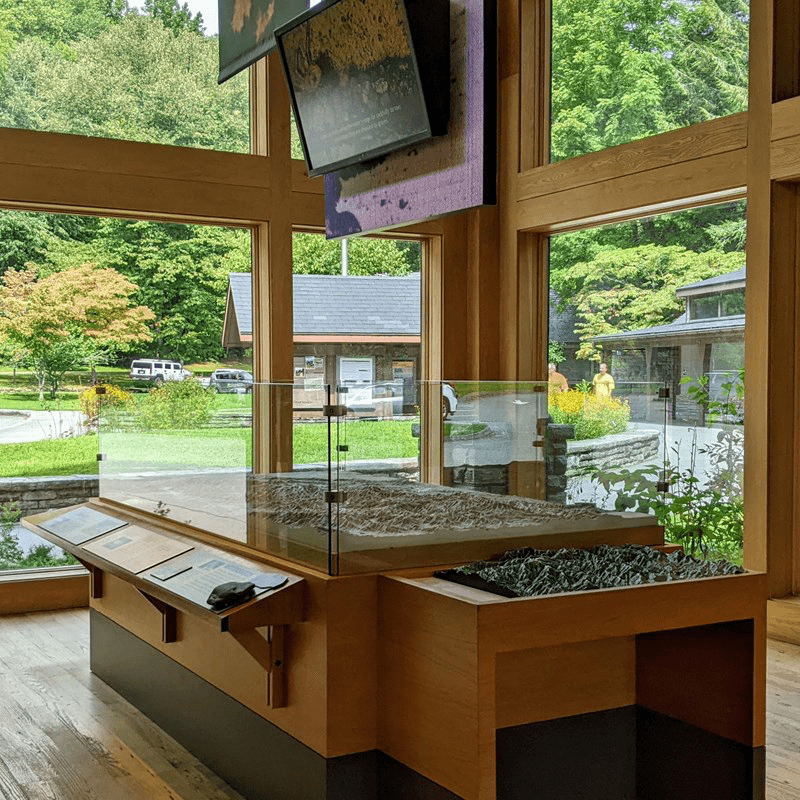The Ultimate Guide: The Great Smoky Mountains National Park
The Great Smoky Mountains National Park is a protected area in the southeastern United States. Covering a massive 500,000 acres in Tennessee and North Carolina. It is one of the most visited national parks in the country, with millions of people coming each year to enjoy its stunning natural beauty, rich history, and diverse plant and animal life.
For a brief / condensed view of the Smoky Mountains you can check out rvResortScouts Smoky Mountains listing.
Park History / General Overview:
The Great Smoky Mountains National Park has a rich and fascinating history that dates back thousands of years. The land was originally inhabited by various Native American tribes. One of the main tribes was the Cherokee. They lived in the area for centuries and left behind numerous cultural and historical sites. European settlers arrived in the late 18th and early 19th centuries. These European settlers played a key role in the development of the country.
The government officially established the park in 1934. Since then, it has become a beloved destination for millions of visitors from around the world. Its stunning natural beauty and diverse plant and animal life make it a truly unique place to explore. The park is home to over 1,500 species of flowering plants and more than 200 species of birds. This makes the park perfect for any nature lover.
In addition to its natural beauty, the Great Smoky Mountains National Park also has a rich cultural history. The park is home to numerous historic structures and sites, including log cabins, churches, and grist mills, which provide a glimpse into the region’s past. The park is also home to several living history museums. Here visitors can learn about the park’s history and culture through interactive exhibits and demonstrations.
Getting Orientated
The Great Smoky Mountains National Park is located in the Appalachian Mountains, straddling the border between Tennessee and North Carolina. You can access the park from several major cities, including Knoxville, Tennessee and Asheville, North Carolina. There are two main entrances to the park: the Gatlinburg, Tennessee entrance and the Cherokee, North Carolina entrance. The park is divided into two main sections: the Tennessee side and the North Carolina side. Both sides offer a wide range of recreational activities and attractions, including hiking, biking, fishing, and picnicking.
Great Smoky Mountains National Park Essentials
There are a few essential things you should know before visiting The Great Smoky Mountains National Park. First and foremost, the park is open year-round, but some areas may be closed due to inclement weather or maintenance. The park does charge an entrance fee. The fee is $35 per private vehicle or $20 per person for those entering on foot or by bike. It is also important to note that there is no gas available within the park. So make sure to fill up your gas tank before entering. Additionally, the park has a strict Leave No Trace policy, which means you should leave the area as you found it. Do not disturb any plants or animals.
Visitor Centers
The park is home to a number of visitor centers. These centers provide information and resources to help visitors enjoy their stay in the park. These visitor centers offer a variety of services, including park maps, educational exhibits, ranger-led programs, and first aid assistance. Some of the most popular visitor centers in the Great Smoky Mountains National Park include the Sugarlands Visitor Center, the Oconaluftee Visitor Center, and the Cades Cove Visitor Center. These centers are a great place to start your visit to the park. They provide valuable information on the park’s history, geology, and wildlife, as well as tips on how to stay safe and have a memorable experience while exploring the Great Smoky Mountains.

Great Smoky Mountains National: Things You Need to Know
Here are some additional things you should know before visiting The Great Smoky Mountains National Park:
- Pack appropriately: As mentioned, the weather in the park can vary greatly, so it is important to dress appropriately and bring layers. In the winter, temperatures can drop below freezing, so make sure to bring warm clothing, gloves, and a hat. In the summer, temperatures can rise above 90 degrees, so bring plenty of water and sunscreen. This ensures you stay hydrated and protected from the sun.
- Follow bear safety guidelines: The Great Smoky Mountains National Park is home to a number of bear-inhabited areas, so it is important to follow bear safety guidelines. This includes storing all food in bear-proof containers, keeping a safe distance from bears, and not approaching or feeding bears.
- Stay on designated trails: The park has a number of trails for hiking and exploring. It is important to stay on designated trails to protect the park’s natural resources and ensure your safety. Going off-trail can damage plants and wildlife. It can also be dangerous if you are not familiar with the area.
- Leave No Trace: The park has a strict Leave No Trace policy, which means you should leave the area as you found it and not disturb any plants or animals.
- Know your limits: The Great Smoky Mountains National Park has trails ranging in difficulty, so it is important to choose a trail that is appropriate for your physical ability. Make sure to bring enough water and food, and let someone know your plans and expected return time if you are participating in any strenuous activities.
By following these tips and guidelines, you can help protect the park’s natural resources and have a fantastic experience exploring all that the park has to offer.
Great Smoky Mountains National Park: Travel Tips
If you are planning a trip to The Great Smoky Mountains National Park, there are a few travel tips that can help make your experience even better. One of the best ways to see the park is by car. There are numerous scenic drives that offer breathtaking views of the surrounding landscape. If you prefer to explore on foot, there are over 800 miles of hiking trails ranging in difficulty. These trails range from easy to extremely strenuous, so plan accordingly. It is also a good idea to bring a map and a compass. Do not rely on cell phone service. It can be spotty in certain areas of the park and nonexistent in others.
Accommodations
There are several options for accommodations within The Great Smoky Mountains National Park, including hotels, motels, and cabins. There are also a number of campgrounds within the park. These options range from developed sites with amenities like restrooms and water to backcountry campsites. If you are interested in backcountry camping, it is important to obtain a permit in advance and follow all park regulations. You can only backcountry camp in designated areas. You must plan properly to ensure a safe and enjoyable experience.
The Great Smoky Mountains National Park Safety
Great Smoky Mountains National Park is a safe place to visit. But it is always important to take precautions to ensure your safety. It is a good idea to bring a first aid kit and know basic first aid skills. You never know when an emergency might strike. It is also important to stay on designated trails and be aware of your surroundings, as there are potential hazards such as steep drop-offs, wildlife, and inclement weather. If you are planning any strenuous activities, make sure to bring enough water and food, as well as tell someone your plans and expected return time.
What’s in the Surrounding Area
The Great Smoky Mountains National Park is located in a beautiful and vibrant region of the southeastern United States, and there is plenty to see and do in the surrounding area. Nearby cities like Gatlinburg and Pigeon Forge, Tennessee offer a wide range of attractions and entertainment for visitors of all ages.
Gatlinburg
Gatlinburg is a popular tourist destination located just outside the park’s main entrance. The city boasts a charming downtown area filled with shops, restaurants, and attractions. Some popular attractions in Gatlinburg include:
- The Gatlinburg SkyBridge, a pedestrian bridge that spans 680 feet across a valley.
- The Gatlinburg Space Needle, a 407-foot tall observation tower.
- The city is also home to a number of amusement parks, including Anakeesta and Sky Lift Park, which offer a variety of rides and attractions for the whole family.
- The city boasts a charming downtown area filled with shops, restaurants, and attractions.
Pigeon Forge
Pigeon Forge, Tennessee is another popular city located near the Great Smoky Mountains National Park. The city offers a range of entertainment options, such as live music, theater, and dining. Some popular attractions in Pigeon Forge include Dollywood, a theme park owned by country music star Dolly Parton, and the Titanic Museum Attraction, which offers an immersive look at the history of the famous ocean liner.
In addition to the nearby cities, the region surrounding the Great Smoky Mountains National Park is home to a number of other natural and cultural attractions. The Blue Ridge Parkway, a 469-mile scenic roadway that runs through Virginia and North Carolina, offers breathtaking views of the Appalachian Mountains and is a popular destination for hikers, bikers, and drivers. The Biltmore Estate, a historic mansion and garden located in Asheville, North Carolina, is also a popular attraction in the area. The estate, which was built in the late 19th century, is open to the public and offers tours, gardens, and a winery.
Great Smoky Mountains Wrap Up
In conclusion, The Great Smoky Mountains National Park is a truly unique and breathtaking destination that offers something for everyone. From its rich history and cultural significance to its stunning natural beauty and diverse plant and animal life, there is no shortage of things to see and do in the park. Whether you prefer hiking, fishing, or simply taking in the breathtaking views, the Smokies are a must-visit destination for anyone looking to escape the hustle and bustle of everyday life and connect with nature. So pack your bags, grab your map and compass, and get ready to explore all that this incredible national park has to offer.


